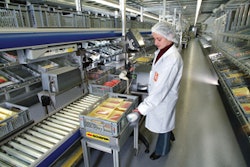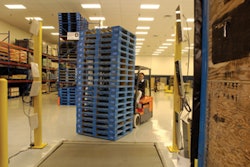This series originally appeared on SDCExec.com in March 2007.
New York — June 18, 2007 — In part one of this two-part series, we learned that while procurement organizations have been focusing on managing big-ticket line items that gobble up large percentages of an enterprise's spend, low-cost chemicals could be eating away at a company's bottom line and raising the business' overall risk profile. Today we examine "Compliance-Side Total Chemical Management," an alternative approach to managing chemicals that puts equal emphasis on the bottom-line and environmental health and safety benefits of getting better control of your chemical spend.
A typical large corporation may have a centralized procurement organization spending billions of dollars on chemicals every year, but the company also quite likely has many more "purchasing points" throughout the enterprise, at various facilities scattered throughout the globe, buying a wide variety of chemicals specific to each remote unit.
Those chemical stocks can be "invisible" to central procurement because spend management systems might not capture those low-level, local purchases. And that leaves those toxic substances beyond the control of procurement and a company's environmental health and safety (EHS) department.
"That's a financial — and potentially a safety and liability — nightmare," says Mark Wysong, head of solution provider Dolphin Safe Source and author of "The Nontoxic CEO: Protecting Your People, Planet and Profits through Better Chemical Management." "Until you automate the compliance data that is required for each of those products — no matter how small a volume — you can't understand the threat the chemicals pose."
The Problem with ERP
In his book, Wysong makes the case for Compliance-Side Total Chemical Management (CSTCM), a process for capturing data on a company's total chemical spend and leveraging that data to better manage both that spend and the chemicals themselves on an enterprise-wide basis.
"With CSTCM, through the compliance data for OSHA and EPA, we see the chemical usage," says Wysong. "It's beyond what any ERP, or enterprise planning system can see, because CSTCM picks up all those little local purchases."
The problem with ERP systems, as Wysong sees it, is that they frequently look at bulk or high leverage opportunities, missing the trees for the big picture, in a sense. By implementing a CSTCM process, companies can collect data on every chemical they purchase and use that information to look for patterns and, ultimately, streamline procurement.
Leveraging EHS
The key is that companies already are collecting all the data that they need for CSTCM in the mandated material safety data sheets (MSDSs) that they must maintain for purposes of compliance with federal and state environmental regulations. As a result, enterprises that deal with hazardous chemicals don't need to create a new office to do chemical management; they can implement CSTCM through their current EHS efforts.
In the process, CSTCM helps the company move its environmental health and safety department away from being a "necessary expense" and toward being a contributor to the bottom line. "Simply put, Compliance-Side Total Chemical Management leverages the EHS departments and finds a way to turn those EHS people into big money savers," Wysong says.
What kind of savings are we talking about here? Wysong believes that, although potential savings will vary by industry, a small company (or an individual unit of a larger company) might have $10-20 million tied up in various chemicals, and that a good CSTCM process could "liberate" capital of between $2 million and $6 million. "That's for one, site-specific, good-size manufacturing or process site," Wysong says. "It's big."
Bigger Profits, Better Planet
Indeed, with an estimated 3 million companies in the United States dealing with hazardous chemicals and mandated to comply with OSHA and EPA regulations, the potential savings across all industries would appear to be significant. But Wysong says that a key success factor in making CSTCM work is getting senior-level executives onboard with the project.
"It has significant potential impact on the bottom line, so C-level people are usually involved in the initial concept adoption," he says. "Then there's coordination with the compliance staff, and with procurement, and a tight tie to the operations managers who have profit responsibilities."
The upside benefits can extend beyond savings, according to Wysong. Companies that do CSTCM can actually better ensure that they are in compliance with environmental regulations. "Their people, the workers, are safer. The environment is cleaner," he says. "That's because CSTCM is all about reducing the number and volume of hazardous chemicals a company buys, stores, uses and disposes of. And that reduction of extreme chemical liabilities benefits companies' people, planet and profits, as I like to say."
New York — June 18, 2007 — In part one of this two-part series, we learned that while procurement organizations have been focusing on managing big-ticket line items that gobble up large percentages of an enterprise's spend, low-cost chemicals could be eating away at a company's bottom line and raising the business' overall risk profile. Today we examine "Compliance-Side Total Chemical Management," an alternative approach to managing chemicals that puts equal emphasis on the bottom-line and environmental health and safety benefits of getting better control of your chemical spend.
A typical large corporation may have a centralized procurement organization spending billions of dollars on chemicals every year, but the company also quite likely has many more "purchasing points" throughout the enterprise, at various facilities scattered throughout the globe, buying a wide variety of chemicals specific to each remote unit.
Those chemical stocks can be "invisible" to central procurement because spend management systems might not capture those low-level, local purchases. And that leaves those toxic substances beyond the control of procurement and a company's environmental health and safety (EHS) department.
"That's a financial — and potentially a safety and liability — nightmare," says Mark Wysong, head of solution provider Dolphin Safe Source and author of "The Nontoxic CEO: Protecting Your People, Planet and Profits through Better Chemical Management." "Until you automate the compliance data that is required for each of those products — no matter how small a volume — you can't understand the threat the chemicals pose."
The Problem with ERP
In his book, Wysong makes the case for Compliance-Side Total Chemical Management (CSTCM), a process for capturing data on a company's total chemical spend and leveraging that data to better manage both that spend and the chemicals themselves on an enterprise-wide basis.
"With CSTCM, through the compliance data for OSHA and EPA, we see the chemical usage," says Wysong. "It's beyond what any ERP, or enterprise planning system can see, because CSTCM picks up all those little local purchases."
The problem with ERP systems, as Wysong sees it, is that they frequently look at bulk or high leverage opportunities, missing the trees for the big picture, in a sense. By implementing a CSTCM process, companies can collect data on every chemical they purchase and use that information to look for patterns and, ultimately, streamline procurement.
Leveraging EHS
The key is that companies already are collecting all the data that they need for CSTCM in the mandated material safety data sheets (MSDSs) that they must maintain for purposes of compliance with federal and state environmental regulations. As a result, enterprises that deal with hazardous chemicals don't need to create a new office to do chemical management; they can implement CSTCM through their current EHS efforts.
In the process, CSTCM helps the company move its environmental health and safety department away from being a "necessary expense" and toward being a contributor to the bottom line. "Simply put, Compliance-Side Total Chemical Management leverages the EHS departments and finds a way to turn those EHS people into big money savers," Wysong says.
What kind of savings are we talking about here? Wysong believes that, although potential savings will vary by industry, a small company (or an individual unit of a larger company) might have $10-20 million tied up in various chemicals, and that a good CSTCM process could "liberate" capital of between $2 million and $6 million. "That's for one, site-specific, good-size manufacturing or process site," Wysong says. "It's big."
Bigger Profits, Better Planet
Indeed, with an estimated 3 million companies in the United States dealing with hazardous chemicals and mandated to comply with OSHA and EPA regulations, the potential savings across all industries would appear to be significant. But Wysong says that a key success factor in making CSTCM work is getting senior-level executives onboard with the project.
"It has significant potential impact on the bottom line, so C-level people are usually involved in the initial concept adoption," he says. "Then there's coordination with the compliance staff, and with procurement, and a tight tie to the operations managers who have profit responsibilities."
The upside benefits can extend beyond savings, according to Wysong. Companies that do CSTCM can actually better ensure that they are in compliance with environmental regulations. "Their people, the workers, are safer. The environment is cleaner," he says. "That's because CSTCM is all about reducing the number and volume of hazardous chemicals a company buys, stores, uses and disposes of. And that reduction of extreme chemical liabilities benefits companies' people, planet and profits, as I like to say."













